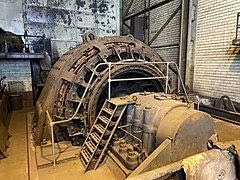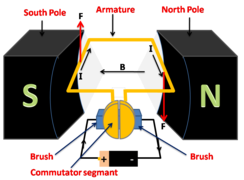Electric Motor - Definition, Types, Working, Parts, Uses, FAQs

What is a motor?
The electric motor, sometimes known as a motor, is one of the most significant scientific breakthroughs ever made. We wouldn't be able to live the way we do today if it weren't for the introduction of motors; otherwise, we'd be consuming power only to light the bulb. A device that converts electrical energy into mechanical energy is known as an electrical motor. In its most basic form, an electrical motor is a device that generates rotational energy. Michael Faraday, in the early 1800s, began bringing out the characteristics and applications of electricity.
What is electric motor class 10?/define electric motor class 10/definition of electric motor class 10:-
An electric motor is a machine that converts electricity into mechanical energy. In most electrical motors, the interaction between the magnetic field of the motor and the electric current in a wire winding generates force in the form of torque imparted to the motor's shaft.

Also read -
- NCERT Solutions for Class 11 Physics
- NCERT Solutions for Class 12 Physics
- NCERT Solutions for All Subjects
Type of electric motor-
- AC Motor ( alternate current )
DC Motor ( Direct current )
AC Motor -
An alternating current motor (AC motor) is a type of electric motor (AC). An outer stationary stator with coils supplied with alternating current to form a rotating magnetic field and an interior rotor coupled to the output shaft that is torqued by the rotating field are the two fundamental pieces.
DC Motor -
A DC motor is an electric motor that runs on direct current and is mechanically commutated (DC). By definition, the stator and stator current are both stationary in space. The commutator switches the current in the rotor, making it stationary in space as well. The highest torque is generated by maintaining the relative angle between the stator and rotor magnetic flux near 90 degrees.
Advantage of AC motor-
Low cost, long life, great efficiency, huge ratings (up to 1 MW), and a vast range of standardized kinds are all advantages of AC motors.
Disadvantage of AC motor-
AC motors have several drawbacks, including a high starting inrush current and the need for a variable frequency source for speed regulation.
Advantage of DC motor-
Precision positioning, high holding torque, long lifespan, little maintenance, and high efficiency are some of the advantages of DC motors.
Disadvantage of DC motor-
DC motors have a number of drawbacks, including the fact that they are often expensive. It necessitates the use of a controller, has a higher initial cost
Related Topics Link, |
Universal motor-
When a series-wound motor is intended to run on both AC and DC power, it is known as a universal motor. It works well with AC because the current in both the field and the armature (and hence the generated magnetic fields) alternates in synchronism, resulting in a constant rotational torque.
Motor parts-
- A coil that is rectangular in shape.
- Two powerful magnets of any type, such as horseshoe magnets or bar magnets. They're utilized to generate a powerful magnetic field.
- The rectangular coil is rotated using split rings.
- The brushes serve as a point of contact for the split rings.
Electric motors and their functions-
- A power supply - A DC power source is commonly found in a simple motor. It supplies electricity to the motor's armature or field coils.
- Field Magnet (may be a permanent magnet or an electromagnet) — The magnetic field helps to produce a torque on the rotating armature coil thanks to Fleming's left-hand law.
- An armature, also known as a rotor, keeps the armature coil in place and provides mechanical support.
- The spinning Armature Coil interfaces with a stationary circuit via the commutator.
- The armature coil is responsible for allowing the engine to run.
- Brushes are a mechanism for conducting current between fixed wires and moving elements, most commonly rotating shafts.
- Axle
Also read :
Working of Motor
Working of electric motor class 10 and principle of electric motors-

Electric motor diagram
Make a little gap between the poles of two bar magnets facing each other. Make a loop with a little length of conductive wire. Maintain this link between the magnets so that it remains within the magnet's influence zone. Now it's time for the final section. Connect the loop ends to the terminals of the battery.
You'll see that your loop moves when power flows through your simple circuit. The magnetic field generated by the conductor's electrical current flow interferes with the magnetic field generated by the magnet. Because the loop has turned into a magnet, one side of it will be drawn to the north pole of the magnet, while the other will be drawn to the south pole. As a result, the loop continues to rotate. This is how an electric motor functions.
Uses of electric motor-
- Electric fans make use of them.
- They're commonly found in washing machines.
- Pumps for water use
Also check-
- NCERT Exemplar Class 11th Physics Solutions
- NCERT Exemplar Class 12th Physics Solutions
- NCERT Exemplar Solutions for All Subjects
NCERT Physics Notes:
Frequently Asked Questions (FAQs)
The motor is a DC motor. The interaction of the stator poles with a component of the rotor, or armature, is required for the operation of a DC motor. The stator has an even number of alternating magnetic polarity poles, each of which is made up of an electromagnet created by wrapping a pole winding around a pole core.
We may improve the motor's turning force (or torque) in three ways: either by using a more powerful permanent magnet, increasing the electric current running through the wire, or making the coil with several "turns" (loops) of very thick wire instead of just one.
Because AC motors can generate more torque with a larger current, they are regarded to be more powerful than DC motors. DC motors, on the other hand, are more efficient and make better use of their input energy.
DC motors have a number of drawbacks.
The initial investment is quite high.
The inclusion of a commutator and brush gear increases the cost of operation and maintenance.
Sparking occurs at the brush, making it unable to operate in explosive and hazardous settings (risk in commutation failure)
The interaction of magnetic and electric fields is crucial to the operation of an electric motor. Electrical motors are divided into two categories. The AC motor and the DC motor are the two types of motors. The AC motor is powered by alternating current, whereas the DC motor is powered by direct current.